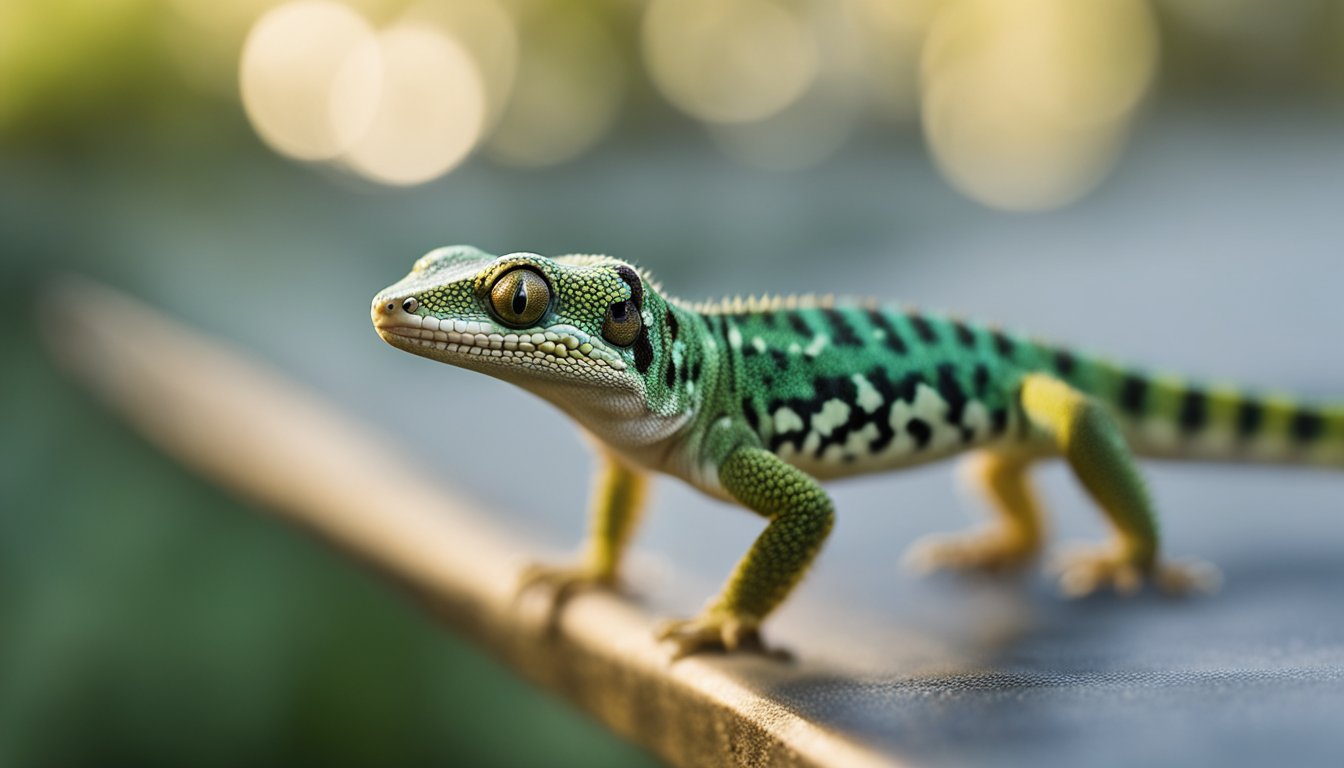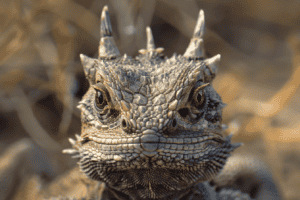Geckos are the superheroes of the lizard world, with an incredible ability to climb up walls and scurry across ceilings as if they’re defying the very laws of gravity.
Have you ever wondered how they manage such a spectacular feat? It’s all down to their remarkable sticky feet.
These tiny creatures have evolved a special adaptation that allows them to stick to almost any surface, making them nimble and quick to escape predators or catch their prey.

Their secret lies in the thousands of microscopic hairs on the bottom of their feet, called setae.
Each of these tiny hairs splits off into even tinier strands known as spatulae.
When geckos walk, these spatulae come so close to the contours of the wall or ceiling that they interact with the surface at the molecular level.
This interaction is so strong, it’s as if the gecko’s feet create an invisible glue that can be easily un-stuck with each step.
Scientists have been studying gecko feet to unlock the secrets of their stickiness, and what they’ve learned is fascinating.
Not only can a gecko’s foot stick to smooth glass, but it can also attach to rough surfaces too.
Plus, those feet are self-cleaning; dirt and debris fall right off, ensuring that each step is as secure as the last.
With feet that can grip nearly any surface, it’s no surprise that geckos are masters of climbing – turning the world into their own personal playground.
The Mystery of Gecko Adhesion
Geckos have a superpower that has left many scratching their heads in amazement.
These incredible creatures can climb smooth surfaces like glass without slipping. Let’s unravel the secrets of their sticky success.
Exploring the Gecko’s Sticky Feet
When you watch a gecko dart up a wall, have you ever wondered why they don’t fall?
That’s because their feet are covered in tiny hairs called setae. Each seta splits into even tinier strands known as spatulae.
These microscopic spatulae are what allow geckos to stick to surfaces with ease.
Believe it or not, if you had feet like a gecko, you could stick to a wall just by the tips of your toes!
The Science Behind the Stickiness
The reason geckos can hold on so well is due to the intimate contact their spatulae make with the surface.
When a gecko steps, these strands get so close to the contours of the wall or ceiling, they exploit a particular kind of physical bond to stick.
It’s not magic; it’s science at its most fascinating.
Van der Waals Forces at Play
Now, for the secret sauce: Van der Waals forces. These are invisible forces that operate at the molecular level.
Every spatula of a gecko’s foot leverages these forces to create an attraction with the surface.
The combined strength of countless spatulae allows geckos to adhere firmly to surfaces without any glue or suction cups—and the best part?
They can release their grip in an instant to move swiftly and gracefully.
Their ability to stick and unstick without any mess is something scientists are trying to replicate with new materials and adhesives.
Now that’s pretty sticky stuff, isn’t it?
Adaptations for Perfect Climbing

Geckos are amazing climbers, thanks to their unique physical adaptations. They can scamper up walls and dash across ceilings with ease.
Let’s discover how these tiny creatures perform such gravity-defying feats.
Tail Tales: Balance and Support
The tail of a gecko is a crucial tool for maintaining balance.
When a gecko navigates across uneven surfaces, its tail acts as a counterweight, aiding in stability.
If they happen to slip, the tail can quickly snap to the surface, creating a stabilizing point.
This not only helps them recover but also prevents falls from great heights.
Additionally, in some species, if a predator grabs the tail, it can detach, allowing the gecko to escape and later regenerate a new one.
Toes and Traction: A Closer Look
A gecko’s toes are marvels of nature’s engineering.
They are lined with hundreds of tiny hairs called setae, which are split into even smaller strands named spatulae at their tips.
These structures operate on the principles of molecular attraction, with each hair capable of creating a bond that holds the gecko’s foot to the surface.
When a gecko walks, it angles its toes in a way that maximizes surface contact.
The genius lies in the flexibility to release these bonds at will, enabling geckos to lift their feet with ease and move swiftly without getting stuck.
The Role of Gecko Feet in Nature

Gecko feet are not your average animal paws; they’re a masterpiece of nature’s design, allowing these little lizards to scurry across walls and ceilings with ease.
In this section, we’ll explore just how their sticky feet play a crucial role in their survival and have even inspired some human innovations.
From Predators to Escape Artists
One of the most astonishing aspects of gecko locomotion is their ability to evade predators with remarkable agility.
Their toes, equipped with hundreds of tiny bristles called setae, help them adhere to almost any surface, making the world their playground.
Imagine trying to catch a superhero who can run up the side of a building! That’s what predators face when they’re after geckos.
Can you believe that a single gecko foot has about a billion tiny hair-like structures called spatulae?
These minuscule spatulae create a powerful bond with surfaces at the molecular level, using a phenomenon known as van der Waals forces.
This bond is so strong that geckos can hang by a single toe!
Gecko Feet and Human Innovation
The secret of gecko feet has not only helped them but has also sparked a wave of human innovation.
Picture a world where gloves and shoes mimic gecko stickiness, letting people climb walls effortlessly, or where tape and adhesives don’t leave a residue thanks to a gecko-inspired design.
Scientists have studied the microstructure of gecko footpads to develop new, reusable adhesives that work under the same principles.
This technology, called “geckskin,” holds significant promise for advancements in robotics, medical devices, and even as a new way to hang up your posters without damaging the walls.
The brilliance of geckos has leapt from the tree branches straight into the human laboratory, hasn’t it?
Frequently Asked Questions

Geckos are amazing climbers, and their feet hold the secret to their impressive abilities.
These questions dive into the wonders of how gecko feet stick to surfaces, supporting their survival and inspiring new technologies.
What are the special features of gecko feet that allow them to climb vertical surfaces?
Gecko feet are wonders of nature, equipped with tiny structures called setae.
These setae end in even smaller spatulae that make close contact with surfaces at a molecular level, creating an adhesive force that allows geckos to scale vertical walls with ease.
Can you explain how the science behind sticky gecko feet helps them defy gravity?
The phenomenon that allows geckos to ‘defy gravity’ is due to van der Waals forces.
These arise from the attraction between the molecules in the gecko’s foot and those on the surface it is climbing.
This molecular attraction provides sufficient grip for them to ascend vertical spaces comfortably.
What role do the tiny hairs on gecko feet play in their amazing climbing abilities?
Each gecko foot is covered with millions of the aforementioned tiny hairs, known as setae.
These setae increase the surface area of the foot, maximizing contact with the climbing surface.
The spatulae at the tip of each seta can conform to even the smoothest surfaces, thereby enhancing the gecko’s gripping power.
How do geckos use their unique feet to support their daily activities and survival?
Gecko feet are not only used for impressive climbing feats but also play a crucial role in their survival.
The ability to escape predators by swiftly running up a tree or to hunt for food on ceilings and walls gives geckos an evolutionary edge in their habitats.
In what ways have gecko feet inspired new technologies or materials through biomimicry?
The remarkable traits of gecko feet have inspired scientists to develop new adhesive materials and technologies.
By mimicking the non-sticky, reusable nature of the adhesive properties of gecko feet, researchers have created tapes and grips that can be applied in various industrial and medical contexts without leaving residue.
Are there any special care or unique challenges that come with the gecko’s sticky feet in their natural habitat?
In the natural habitat of geckos, their sticky feet are an asset but can also pose unique challenges.
Dirt and dust might diminish the adhesive ability of their feet, requiring geckos to clean them regularly.
This self-cleaning mechanism is as vital as the stickiness itself for maintaining their climbing prowess.









